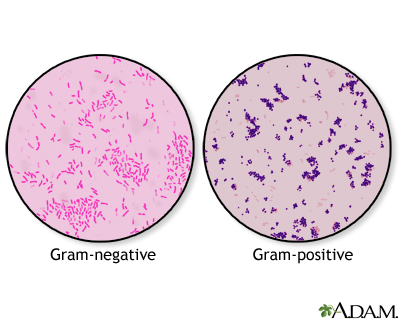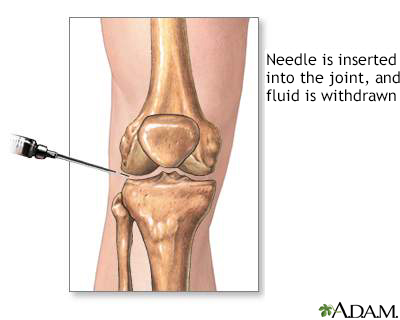Joint fluid Gram stain
Gram stain of joint fluid
Joint fluid Gram stain is a laboratory test to identify bacteria in a sample of joint fluid using a special series of stains (colors). The Gram stain method is one of the most commonly used methods to rapidly identify the cause of bacterial infections.
Images


How the Test is Performed
A sample of joint fluid is needed. This may be done in a health care provider's office using a needle, or during an operating room procedure. Removing the sample is called joint fluid aspiration.
The fluid sample is sent to a lab where a drop of fluid is spread in a very thin layer onto a microscope slide. This is called a smear. Several different colored stains are applied to the sample. The laboratory personnel will look at the stained smear under a microscope to see if bacteria are present. The color, size, and shape of the cells help identify the bacteria.
How to Prepare for the Test
Your provider will tell you how to prepare for the procedure. No special preparation is needed. But, tell your provider if you're taking a blood thinner, such as aspirin, warfarin (Coumadin) or clopidogrel (Plavix). These medicines can affect test results or your ability to take the test.
How the Test will Feel
Sometimes, the provider will first inject numbing medicine into the skin with a small needle, which may sting. A larger needle is then used to draw out the synovial fluid.
This test may also cause some discomfort if the tip of the needle touches bone. The procedure usually lasts less than 1 to 2 minutes.
Why the Test is Performed
The test is performed when there is unexplained swelling, joint pain, and inflammation of a joint, or to check for suspected joint infection.
Normal Results
A normal result means no bacteria are present on the Gram stain.
What Abnormal Results Mean
Abnormal results mean bacteria were seen on the Gram stain. This may be a sign of a joint infection, for example, gonococcal arthritis due to bacteria called Neisseria gonorrhoeae or arthritis due to bacteria called Staphylococcus aureus.
Risks
Risks of this test include:
- Infection of the joint -- unusual, but more common with repeated aspirations
- Bleeding into the joint space
Related Information
Joint painGonococcal arthritis
References
El-Gabalawy HS, Tanner S. Synovial fluid analyses, synovial biopsy, and synovial pathology. In: Firestein GS, Budd RC, Gabriel SE, Koretzky GA, McInnes IB, O'Dell JR, eds. Firestein & Kelly's Textbook of Rheumatology. 11th ed. Philadelphia, PA: Elsevier; 2021:chap 56.
Karcher DS, McPherson RA. Cerebrospinal, synovial, serous body fluids, and alternative specimens. In: McPherson RA, Pincus MR, eds. Henry's Clinical Diagnosis and Management by Laboratory Methods. 24th ed. Philadelphia, PA: Elsevier; 2022:chap 30.
BACK TO TOPReview Date: 12/4/2022
Reviewed By: Jatin M. Vyas, MD, PhD, Associate Professor in Medicine, Harvard Medical School; Associate in Medicine, Division of Infectious Disease, Department of Medicine, Massachusetts General Hospital, Boston, MA. Also reviewed by David C. Dugdale, MD, Medical Director, Brenda Conaway, Editorial Director, and the A.D.A.M. Editorial team.

Health Content Provider
06/01/2025
|
A.D.A.M., Inc. is accredited by URAC, for Health Content Provider (www.urac.org). URAC's accreditation program is an independent audit to verify that A.D.A.M. follows rigorous standards of quality and accountability. A.D.A.M. is among the first to achieve this important distinction for online health information and services. Learn more about A.D.A.M.'s editorial policy, editorial process and privacy policy. A.D.A.M. is also a founding member of Hi-Ethics. This site complied with the HONcode standard for trustworthy health information from 1995 to 2022, after which HON (Health On the Net, a not-for-profit organization that promoted transparent and reliable health information online) was discontinued. |
The information provided herein should not be used during any medical emergency or for the diagnosis or treatment of any medical condition. A licensed medical professional should be consulted for diagnosis and treatment of any and all medical conditions. Links to other sites are provided for information only -- they do not constitute endorsements of those other sites. © 1997- 2024 A.D.A.M., a business unit of Ebix, Inc. Any duplication or distribution of the information contained herein is strictly prohibited.
